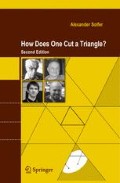Abstract
A rectangular p × 2q pool table has pockets in every corner and in themiddle of each 2q-long side (see Figure 1.1). A ball is rolled from a corner pocket at a 45°. angle with respect to the side rails.
Find necessary and sufficient conditions on the real numbers p and q for the ball to eventually get into a pocket (angle of incidence is equal to the angle of reflection).
Access this chapter
Tax calculation will be finalised at checkout
Purchases are for personal use only
Preview
Unable to display preview. Download preview PDF.
Author information
Authors and Affiliations
Corresponding author
Rights and permissions
Copyright information
© 2009 Springer-Verlag New York
About this chapter
Cite this chapter
Soifer, A. (2009). A Pool Table, Irrational Numbers, and Integral Independence. In: How Does One Cut a Triangle?. Springer, New York, NY. https://doi.org/10.1007/978-0-387-74652-4_1
Download citation
DOI: https://doi.org/10.1007/978-0-387-74652-4_1
Published:
Publisher Name: Springer, New York, NY
Print ISBN: 978-0-387-74650-0
Online ISBN: 978-0-387-74652-4
eBook Packages: Mathematics and StatisticsMathematics and Statistics (R0)

